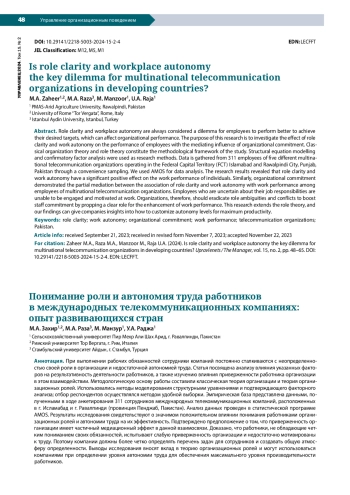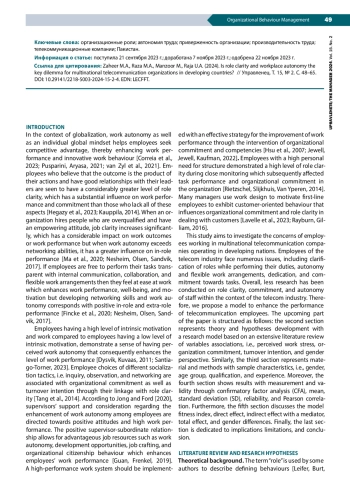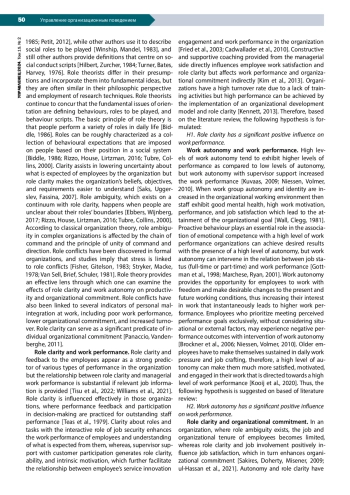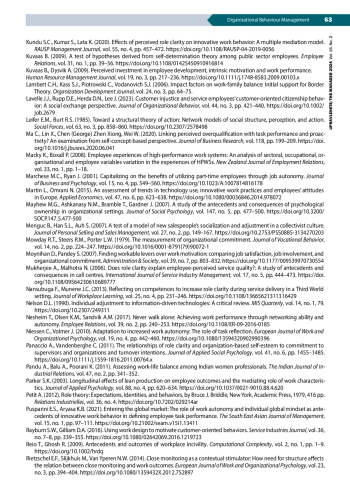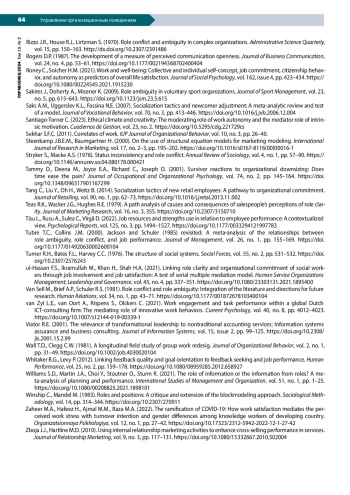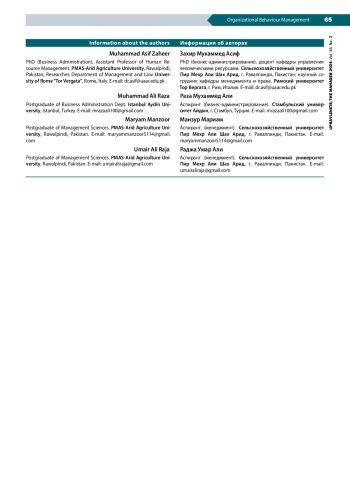Role clarity and workplace autonomy are always considered a dilemma for employees to perform better to achieve their desired targets, which can affect organizational performance. The purpose of this research is to investigate the effect of role clarity and work autonomy on the performance of employees with the mediating influence of organizational commitment. Classical organization theory and role theory constitute the methodological framework of the study. Structural equation modelling and confirmatory factor analysis were used as research methods. Data is gathered from 311 employees of five different multinational telecommunication organizations operating in the Federal Capital Territory (FCT) Islamabad and Rawalpindi City, Punjab, Pakistan through a convenience sampling. We used AMOS for data analysis. The research results revealed that role clarity and work autonomy have a significant positive effect on the work performance of individuals. Similarly, organizational commitment demonstrated the partial mediation between the association of role clarity and work autonomy with work performance among employees of multinational telecommunication organizations. Employees who are uncertain about their job responsibilities are unable to be engaged and motivated at work. Organizations, therefore, should eradicate role ambiguities and conflicts to boost staff commitment by propping a clear role for the enhancement of work performance. This research extends the role theory, and our findings can give companies insights into how to customize autonomy levels for maximum productivity.
Идентификаторы и классификаторы
- SCI
- Социология
- УДК
- 316. Социология
In the context of globalization, work autonomy as well as an individual global mindset helps employees seek competitive advantage, thereby enhancing work performance and innovative work behaviour [Correia et al., 2023; Pusparini, Aryasa, 2021; van Zyl et al., 2021]. Employees who believe that the outcome is the product of their actions and have good relationships with their leaders are seen to have a considerably greater level of role clarity, which has a substantial influence on work performance and commitment than those who lack all of these aspects [Hegazy et al., 2023; Kauppila, 2014].
Список литературы
1. Aisyah N., Wolor C.W., Usman O. (2021). The effect of job satisfaction and work-life balance on employee performance with organizational commitment as mediating variable. Oblik i Finansi / Accounting and Finance, no. 3(93), pp. 97-106. DOI: 10.33146/2307-9878-2021-3(93)-97-106
2. Ahuja M.K., Chudoba K.M., Kacmar C.J., McKnight D.H., George J.F. (2007). IT road warriors: Balancing work-family conflict, job autonomy, and work overload to mitigate turnover intentions. MIS Quarterly, vol. 31, no. 1, pp. 1-17. DOI: 10.2307/25148778
3. Anisa H. (2012). Relationship between organizational commitment and organizational citizenship behavior. The IUP Journal of Organizational Behavior, vol. 11, no. 3, pp. 7-22. DOI: 10.5829/idosi.wjmbs.2013.1.1.1104
4. Aubé C., Rousseau V., Morin E.M. (2007). Perceived organizational support and organizational commitment: The moderating effect of locus of control and work autonomy. Journal of Managerial Psychology, vol. 22, no. 5, pp. 479-495. DOI: 10.1108/02683940710757209
5. Bentler P.M., Bonett D.G. (1980). Significance tests and goodness of fit in the analysis of covariance structures. Psychological Bulletin, vol. 88, no. 3, pp. 588-606. DOI: 10.1037/0033-2909.88.3.588
6. Biddle B.J. (1986). Recent developments in role theory. Annual Review of Sociology, vol. 12, no. 1, pp. 67-92. DOI: 10.1146/annurev.so.12.080186.000435
7. Breaugh J.A. (1985). The measurement of work autonomy. Human Relations, vol. 38, issue 6. DOI: 10.1177/001872678503800604 EDN: JMJONR
8. Brockner J., Flynn F.J., Dolan R.J., Ostfield A., Pace D., Ziskin I.V. (2006). Commentary on “radical HRM innovation and competitive advantage: The Moneyball story”. Human Resource Management, vol. 45, no. 1, pp. 127-145. https://doi.org/10.1002/hrm.
9. Cadwallader S., Jarvis C.B., Bitner M.J., Ostrom A.L. (2010). Frontline employee motivation to participate in service innovation implementation. Journal of the Academy of Marketing Science, vol. 38, no. 2, pp. 219-239. DOI: 10.1007/s11747-009-0151-3 EDN: VMYVYV
10. Correia R.J., Dias J.G., Teixeira M.S., Campos S. (2023). Building competitive advantages and business success: The role of learning orientation, reward systems and entrepreneurial orientation. European Business Review, vol. 35, no. 1, pp. 92-119. DOI: 10.1108/EBR-03-2022-0051 EDN: OFOWPB
11. Cua K.O., McKone K.E., Schroeder R.G. (2001). Relationships between implementation of TQM, JIT, and TPM and manufacturing performance. Journal of Operations Management, vol. 19, no. 6, pp. 675-694. DOI: 10.1016/S0272-6963(01)00066-3 EDN: DYRIRN
12. Day D.V., Gerstner C.R. (1997). Meta-analytic review of leader-member exchange theory: Correlates and construct issues. Journal of Applied Psychology, vol. 82, no. 6, pp. 827-844. DOI: 10.1037/0021-9010.82.6.827 EDN: GWWOMX
13. De Souza G.E., Beuren I.M. (2018). Impact of an enabling performance measurement system on task performance and job satisfaction. Revista Contabilidade e Financas, vol. 29, no. 77, pp. 194-212. DOI: 10.1590/1808-057x201805850
14. Dhondt S., Pot F.D., Kraan K.O. (2014). The importance of organizational level decision latitude for well-being and organizational commitment. Team Performance Management, vol. 20, no. 7, pp. 307-327. DOI: 10.1108/TPM-03-2014-0025
15. Dinger M., Thatcher J.B., Treadway D., Stepina L., Breland J. (2015). Does professionalism matter in the it workforce? An empirical examination of it professionals. Journal of the Association for Information Systems, vol. 16, no. 4, pp. 281-313. DOI: 10.17705/1jais.00392
16. Doll W.J., Xia W., Torkzadeh G. (1994). A confirmatory factor analysis of the end-user computing satisfaction instrument. MIS Quarterly: Management Information Systems, vol. 18, no. 4, pp. 453-461. DOI: 10.2307/249524 EDN: BVXRFR
17. Dysvik A., Kuvaas B. (2011). Intrinsic motivation as a moderator on the relationship between perceived job autonomy and work performance. European Journal of Work and Organizational Psychology, vol. 20, no. 3, pp. 367-387. DOI: 10.1080/13594321003590630
18. Ebbers J.J., Wijnberg N.M. (2017). Betwixt and between: Role conflict, role ambiguity and role definition in project-based dualleadership structures. Human Relations, vol. 70, no. 11, pp. 1342-1365. DOI: 10.1177/0018726717692852
19. Fincke I., Hieb A., Harth V., Mache S. (2020). Activity-based working: Qualitative analysis of working conditions and healthrelated outcomes. Work, vol. 67, no. 3, pp. 625-639. DOI: 10.3233/wor-203313 EDN: ODPTZY
20. Fisher C.D., Gitelson R. (1983). A meta-analysis of the correlates of role conflict and ambiguity. Journal of Applied Psychology, vol. 68, no. 2, pp. 320-333. DOI: 10.1037/0021-9010.68.2.320
21. Fornell C., Larcker D.F. (1981). Evaluating structural equation models with unobservable variables and measurement error. Journal of Marketing Research, vol. 18, no. 1, pp. 39-50. DOI: 10.2307/3151312
22. Fried Y., Slowik L.H., Shperling Z., Franz C., Ben-David H.A., Avital N., Yeverechyahu U. (2003). The moderating effect of job security on the relation between role clarity and job performance: A longitudinal field study. Human Relations, vol. 56, no. 7, pp. 787-805. DOI: 10.1177/00187267030567002 EDN: JMKGVV
23. Gajendran R.S., Harrison D.A. (2007). The good, the bad, and the unknown about telecommuting: Meta-analysis of psychological mediators and individual consequences. Journal of Applied Psychology, vol. 92, no. 6, pp. 1524-1541. DOI: 10.1037/0021-9010.92.6.1524
24. Gottman J.M., Coan J., Carrere S., Swanson C., Gottman J.M., Coan J., Carrere S., Swanson C. (1998). Predicting marital happiness and stability from newlywed interactions. Journal of Marriage and Family, vol. 60, no. 1, pp. 5-22. https://doi.org/10.1002/job. EDN: CSYEBF
25. Guan X., Frenkel S.J. (2019). Explaining supervisor-subordinate guanxi and subordinate performance through a conservation of resources lens. Human Relations, vol. 72, no. 11, pp. 1752-1775. DOI: 10.1177/0018726718813718
26. Hackman J.R., Oldham G.R. (1976). Motivation through the design of work: Test of a theory. Organizational Behavior and Human Performance, vol. 16, issue 2, pp. 250-279. DOI: 10.1016/0030-5073(76)90016-7
27. Hair J.F., Anderson R.E., Tatham R.L., Black W.C. (2019). Multivariate data analysis. Pearson College Div.
28. Hassan S. (2013). The importance of role clarification in workgroups: Effects on perceived role clarity, work satisfaction, and turnover rates. Public Administration Review, vol. 73, no. 5, pp. 716-725. DOI: 10.1111/puar.12100
29. Hegazy M., El-Deeb M.S., Hamdy H.I., Halim Y.T. (2023). Effects of organizational climate, role clarity, turnover intention, and workplace burnout on audit quality and performance. Journal of Accounting and Organizational Change, vol. 19, issue 5, pp. 765-789. DOI: 10.1108/JAOC-12-2021-0192 EDN: DZFBXH
30. Hilbert R.A., Zurcher L.A. (1984). Social roles: Conformity, conflict, and creativity. Contemporary Sociology, vol. 13, no. 4, p. 522. DOI: 10.2307/2069136
31. Hsu I.C., Lin C.Y.Y., Lawler J., Wu S.H. (2007). Toward a model of organizational human capital development: Preliminary evidence from Taiwan. Asia Pacific Business Review, vol. 13, no. 2, pp. 251-275. DOI: 10.1080/13602380701233547
32. Hu L.T., Bentler P.M. (1999). Cutoff criteria for fit indexes in covariance structure analysis: Conventional criteria versus new alternatives. Structural Equation Modeling, vol. 6, no. 1, pp. 1-55. DOI: 10.1080/10705519909540118
33. Hussain A. (2014). The relationship between breach of psychological contract and workplace deviant behavior. IUP Journal of Organizational Behavior, vol. 13, no. 2, pp. 25-37.
34. Jawaad M., Amir A., Bashir A., Hasan T. (2019). Human resource practices and organizational commitment: The mediating role of job satisfaction in emerging economy. Cogent Business and Management, vol. 6, no. 1, 1608668. DOI: 10.1080/23311975.2019.1608668 EDN: DSFSCG
35. Jewell D.O., Jewell S.F., Kaufman B.E. (2022). Designing and implementing high-performance work systems: Insights from consulting practice for academic researchers. Human Resource Management Review, vol. 32, no. 1, 100749. DOI: 10.1016/j.hrmr.2020.100749 EDN: YKRAVI
36. Jong J., Ford M. (2020). An exploration of the relationship between autonomy congruence, perceived supervisor individualized consideration, and employee outcomes. Review of Public Personnel Administration, vol. 41, issue 3, pp. 566-592. DOI: 10.1177/0734371X20917185 EDN: JCDGGU
37. Kaplan M., Kaplan A. (2018). The relationship between organizational commitment and work performance: A case of industrial enterprises. Journal of Economic and Social Development (JESD), vol. 5, no. 1, pp. 46-50.
38. Kauppila O.P. (2014). So, what am i supposed to do? A multilevel examination of role clarity. Journal of Management Studies, vol. 51, no. 5, pp. 737-763. DOI: 10.1111/joms.12042
39. Kennett G. (2013). The impact of training practices on individual, organisation, and industry skill development. Australian Bulletin of Labour, vol. 39, no. 1, pp. 112-135.
40. Khan M.J., Saleem K. (2021). Laissez-faire leadership style in universities’ faculty while adopting the creating style to assess the employee performance. Journal of Managerial Sciences, vol. 15, pp. 157-169. DOI: 10.5267/j.msl.2021.8.005
41. Kim S., Egan T.M., Kim W., Kim J. (2013). The impact of managerial coaching behavior on employee work-related reactions. Journal of Business and Psychology, vol. 28, no. 3, pp. 315-330. DOI: 10.1007/s10869-013-9286-9 EDN: WUEYID
42. Kokubun K., Yasui M. (2020). Gender differences in organizational commitment and rewards within Japanese manufacturing companies in China. Cross Cultural and Strategic Management, vol. 28, no. 3, pp. 501-529. DOI: 10.1108/CCSM-062019-0119
43. Kooij D.T.A.M., Nijssen H., Bal P.M., van der Kruijssen D.T.F. (2020). Crafting an interesting job: Stimulating an active role of older workers in enhancing their daily work engagement and job performance. Work, Aging and Retirement, vol. 6, no. 3, pp. 165-174. DOI: 10.1093/workar/waaa001 EDN: LCJAPZ
44. Kundu S.C., Kumar S., Lata K. (2020). Effects of perceived role clarity on innovative work behavior: A multiple mediation model. RAUSP Management Journal, vol. 55, no. 4, pp. 457-472. DOI: 10.1108/RAUSP-04-2019-0056
45. Kuvaas B. (2009). A test of hypotheses derived from self-determination theory among public sector employees. Employee Relations, vol. 31, no. 1, pp. 39-56. DOI: 10.1108/01425450910916814
46. Kuvaas B., Dysvik A. (2009). Perceived investment in employee development, intrinsic motivation and work performance. Human Resource Management Journal, vol. 19, no. 3, pp. 217-236. DOI: 10.1111/j.1748-8583.2009.00103.x
47. Lambert C.H., Kass S.J., Piotrowski C., Vodanovich S.J. (2006). Impact factors on work-family balance: Initial support for Border Theory. Organization Development Journal, vol. 24, no. 3, pp. 64-75.
48. Lavelle J.J., Rupp D.E., Herda D.N., Lee J. (2023). Customer injustice and service employees’ customer-oriented citizenship behavior: A social exchange perspective. Journal of Organizational Behavior, vol. 44, no. 3, pp. 421-440. DOI: 10.1002/job.2679 EDN: YCPBMJ
49. Leifer E.M., Burt R.S. (1985). Toward a structural theory of action: Network models of social structure, perception, and action. Social Forces, vol. 63, no. 3, pp. 858-860. DOI: 10.2307/2578498
50. Ma C., Lin X., Chen (George) Zhen Xiong, Wei W. (2020). Linking perceived overqualification with task performance and proactivity? An examination from self-concept-based perspective. Journal of Business Research, vol. 118, pp. 199-209. DOI: 10.1016/j.jbusres.2020.06.041
51. Macky K., Boxall P. (2008). Employee experiences of high-performance work systems: An analysis of sectoral, occupational, organisational and employee variables variation in the experiences of HPWSs. New Zealand Journal of Employment Relations, vol. 33, no. 1, pp. 1-18.
52. Marchese M.C., Ryan J. (2001). Capitalizing on the benefits of utilizing part-time employees through job autonomy. Journal of Business and Psychology, vol. 15, no. 4, pp. 549-560. https://doi.org/10.1023/A:1007814816178. EDN: AMJYLN
53. Martin L., Omrani N. (2015). An assessment of trends in technology use, innovative work practices and employees’ attitudes in Europe. Applied Economics, vol. 47, no. 6, pp. 623-638. DOI: 10.1080/00036846.2014.978072
54. Mayhew M.G., Ashkanasy N.M., Bramble T., Gardner J. (2007). A study of the antecedents and consequences of psychological ownership in organizational settings. Journal of Social Psychology, vol. 147, no. 5, pp. 477-500. DOI: 10.3200/SOCP.147.5.477-500
55. Menguc B., Han S.L., Auh S. (2007). A test of a model of new salespeople’s socialization and adjustment in a collectivist culture. Journal of Personal Selling and Sales Management, vol. 27, no. 2, pp. 149-167. DOI: 10.2753/PSS0885-3134270203
56. Mowday R.T., Steers R.M., Porter L.W. (1979). The measurement of organizational commitment. Journal of Vocational Behavior, vol. 14, no. 2, pp. 224-247. DOI: 10.1016/0001-8791(79)90072-1
57. Moynihan D., Pandey S. (2007). Finding workable levers over work motivation: comparing job satisfaction, job involvement, and organizational commitment. Administration & Society, vol. 39, no. 7, pp. 803-832. DOI: 10.1177/009539970730554 EDN: JKJTLB
58. Mukherjee A., Malhotra N. (2006). Does role clarity explain employee-perceived service quality?: A study of antecedents and consequences in call centres. International Journal of Service Industry Management, vol. 17, no. 5, pp. 444-473. DOI: 10.1108/09564230610689777
59. Nansubuga F., Munene J.C. (2013). Reflecting on competences to increase role clarity during service delivery in a Third World setting. Journal of Workplace Learning, vol. 25, no. 4, pp. 231-246. DOI: 10.1108/13665621311316429
60. Nelson D.L. (1990). Individual adjustment to information-driven technologies: A critical review. MIS Quarterly, vol. 14, no. 1, 79. DOI: 10.2307/249311 EDN: BHAERP
61. Nesheim T., Olsen K.M., Sandvik A.M. (2017). Never walk alone: Achieving work performance through networking ability and autonomy. Employee Relations, vol. 39, no. 2, pp. 240-253. DOI: 10.1108/ER-09-2016-0185
62. Niessen C., Volmer J. (2010). Adaptation to increased work autonomy: The role of task reflection. European Journal of Work and Organizational Psychology, vol. 19, no. 4, pp. 442-460. DOI: 10.1080/13594320902990396
63. Panaccio A., Vandenberghe C. (2011). The relationships of role clarity and organization-based self-esteem to commitment to supervisors and organizations and turnover intentions. Journal of Applied Social Psychology, vol. 41, no. 6, pp. 1455-1485. DOI: 10.1111/j.1559-1816.2011.00764.x
64. Pandu A., Balu A., Poorani K. (2011). Assessing work-life balance among Indian women professionals. The Indian Journal of Industrial Relations, vol. 47, no. 2, pp. 341-352.
65. Parker S.K. (2003). Longitudinal effects of lean production on employee outcomes and the mediating role of work characteristics. Journal of Applied Psychology, vol. 88, no. 4, pp. 620-634. DOI: 10.1037/0021-9010.88.4.620 EDN: GWUJRP
66. Petit A. (2012). Role theory: Expectations, Identities, and behaviors, by Bruce J. Briddle, New York, Academic Press, 1979, 416 pp. Relations Industrielles, vol. 36, no. 4. DOI: 10.7202/029214ar
67. Pusparini E.S., Aryasa K.B. (2021). Entering the global market: The role of work autonomy and individual global mindset as antecedents of innovative work behavior in defining employee task performance. The South East Asian Journal of Management, vol. 15, no. 1, pp. 97-111. DOI: 10.21002/seam.v15i1.13411 EDN: FCHRGX
68. Rayburn S.W., Gilliam D.A. (2016). Using work design to motivate customer-oriented behaviors. Service Industries Journal, vol. 36, no. 7-8, pp. 339-355. DOI: 10.1080/02642069.2016.1219723
69. Reio T., Ghosh R. (2009). Antecedents and outcomes of workplace incivility. Computational Complexity, vol. 2, no. 1, pp. 1-9. https://doi.org/10.1002/hrdq.
70. Rietzschel E.F., Slijkhuis M., Van Yperen N.W. (2014). Close monitoring as a contextual stimulator: How need for structure affects the relation between close monitoring and work outcomes. European Journal of Work and Organizational Psychology, vol. 23, no. 3, pp. 394-404. DOI: 10.1080/1359432X.2012.752897
71. Rizzo J.R., House R.J., Lirtzman S. (1970). Role conflict and ambiguity in complex organizations. Administrative Science Quarterly, vol. 15, pp. 150-163. DOI: 10.2307/2391486
72. Rogers D.P. (1987). The development of a measure of perceived communication openness. Journal of Business Communication, vol. 24, no. 4, pp. 53-61. DOI: 10.1177/002194368702400404
73. Roney C., Soicher H.M. (2021). Work and well-being: Collective and individual self-concept, job commitment, citizenship behavior, and autonomy as predictors of overall life satisfaction. Journal of Social Psychology, vol. 162, issue 4, pp. 423-434. DOI: 10.1080/00224545.2021.1915230 EDN: IFXSBQ
74. Sakires J., Doherty A., Misener K. (2009). Role ambiguity in voluntary sport organizations. Journal of Sport Management, vol. 23, no. 5, pp. 615-643. DOI: 10.1123/jsm.23.5.615
75. Saks A.M., Uggerslev K.L., Fassina N.E. (2007). Socialization tactics and newcomer adjustment: A meta-analytic review and test of a model. Journal of Vocational Behavior, vol. 70, no. 3, pp. 413-446. DOI: 10.1016/j.jvb.2006.12.004
76. Santiago-Torner C. (2023). Ethical climate and creativity: The moderating role of work autonomy and the mediator role of intrinsic motivation. Cuadernos de Gestion, vol. 23, no. 2. DOI: 10.5295/cdg.221729cs EDN: MBTBDO
77. Sekhar S.F.C. (2011). Correlates of work. IUP Journal of Organizational Behavior, vol. 10, no. 3, pp. 26-40.
78. Steenkamp J.B.E.M., Baumgartner H. (2000). On the use of structural equation models for marketing modeling. International Journal of Research in Marketing, vol. 17, no. 2-3, pp. 195-202. DOI: 10.1016/s0167-8116(00)00016-1 EDN: ALFHXN
79. Stryker S., Macke A.S. (1978). Status inconsistency and role conflict. Annual Review of Sociology, vol. 4, no. 1, pp. 57-90. DOI: 10.1146/annurev.so.04.080178.000421
80. Tammy D., Deena M., Joyce E.A., Richard C., Joseph O. (2001). Survivor reactions to organizational downsizing: Does time ease the pain? Journal of Occupational and Organizational Psychology, vol. 74, no. 2, pp. 145-164. DOI: 10.1348/096317901167299 EDN: DMSUBF
81. Tang C., Liu Y., Oh H., Weitz B. (2014). Socialization tactics of new retail employees: A pathway to organizational commitment. Journal of Retailing, vol. 90, no. 1, pp. 62-73. DOI: 10.1016/j.jretai.2013.11.002
82. Teas R.K., Wacker J.G., Hughes R.E. (1979). A path analysis of causes and consequences of salespeople’s perceptions of role clarity. Journal of Marketing Research, vol. 16, no. 3, 355. DOI: 10.2307/3150710
83. Tisu L., Rusu A., Sulea C., Vîrgă D. (2022). Job resources and strengths use in relation to employee performance: A contextualized view. Psychological Reports, vol. 125, no. 3, pp. 1494-1527. DOI: 10.1177/0033294121997783 EDN: NFZXOF
84. Tubre T.C., Collins J.M. (2000). Jackson and Schuler (1985) revisited: A meta-analysis of the relationships between role ambiguity, role conflict, and job performance. Journal of Management, vol. 26, no. 1, pp. 155-169. DOI: 10.1177/014920630002600104 EDN: JNSQQR
85. Turner R.H., Bates F.L., Harvey C.C. (1976). The structure of social systems. Social Forces, vol. 55, no. 2, pp. 531-532. DOI: 10.2307/2576243
86. ul-Hassan F.S., Ikramullah M., Khan H., Shah H.A. (2021). Linking role clarity and organizational commitment of social workers through job involvement and job satisfaction: A test of serial multiple mediation model. Human Service Organizations Management, Leadership and Governance, vol. 45, no. 4, pp. 337-351. DOI: 10.1080/23303131.2021.1895400 EDN: DHZOYZ
87. Van Sell M., Brief A.P., Schuler R.S. (1981). Role conflict and role ambiguity: Integration of the literature and directions for future research. Human Relations, vol. 34, no. 1, pp. 43-71. DOI: 10.1177/001872678103400104 EDN: JMJJYB
88. van Zyl L.E., van Oort A., Rispens S., Olckers C. (2021). Work engagement and task performance within a global Dutch ICT-consulting firm: The mediating role of innovative work behaviors. Current Psychology, vol. 40, no. 8, pp. 4012-4023. DOI: 10.1007/s12144-019-00339-1 EDN: FIFXLO
89. Viator R.E. (2001). The relevance of transformational leadership to nontraditional accounting services: Information systems assurance and business consulting. Journal of Information Systems, vol. 15, issue 2, pp. 99-125. DOI: 10.2308/jis.2001.15.2.99 EDN: DONFFJ
90. Wall T.D., Clegg C.W. (1981). A longitudinal field study of group work redesig. Journal of Organizational Behavior, vol. 2, no. 1, pp. 31-49. DOI: 10.1002/job.4030020104
91. Whitaker B.G., Levy P. (2012). Linking feedback quality and goal orientation to feedback seeking and job performance. Human Performance, vol. 25, no. 2, pp. 159-178. DOI: 10.1080/08959285.2012.658927
92. Williams S.D., Martin J.A., Choi Y., Stoutner O., Sturm R. (2021). The role of information or the information from roles? A meta-analysis of planning and performance. International Studies of Management and Organization, vol. 51, no. 1, pp. 1-25. DOI: 10.1080/00208825.2021.1898101 EDN: BDCPXC
93. Winship C., Mandel M. (1983). Roles and positions: A critique and extension of the blockmodeling approach. Sociological Methodology, vol. 14, pp. 314-344. DOI: 10.2307/270911
94. Zaheer M.A., Hafeez H., Ajmal M.M., Raza M.A. (2022). The ramification of COVID-19: How work satisfaction mediates the perceived work stress with turnover intention and gender differences among knowledge workers of developing country. Organizatsionnaya Psikhologiya, vol. 12, no. 1, pp. 27-42. DOI: 10.17323/2312-5942-2022-12-1-27-42 EDN: ALHUDK
95. Zboja J.J., Hartline M.D. (2010). Using internal relationship marketing activities to enhance cross-selling performance in services. Journal of Relationship Marketing, vol. 9, no. 3, pp. 117-131. DOI: 10.1080/15332667.2010.502004
Выпуск
Другие статьи выпуска
Развитие нейромаркетингового инструментария расширило возможности понимания потребительского поведения на основе изучения нейрофизиологических реакций в ответ на маркетинговые стимулы. Статья посвящена экспериментальному исследованию воздействия цвета упаковки на потребительское поведение при выборе сырной продукции. Методологический каркас представлен теорией сенсорного маркетинга. В работе применяются нейрофизиологические методы, позволяющие отследить реакцию потребителей в процессе визуального изучения цвета упаковки. Информационную базу для получения верифицированных результатов составили данные электроэнцефалограммы (ЭЭГ), а также эмоциональных реакций, выявленных путем лицевого кодирования мимических выражений. Векторы эмоциональной реакции оценивались с помощью программы EmoDetect. Результаты исследования показали, что цвет упаковки сыра влияет на потребительский выбор. Восприятие цвета зависит от гендерного фактора и товарной группы. На основе анализа данных ЭЭГ выявлено, что наиболее сильная эмоциональная реакция у женщин была вызвана упаковкой сыра красного цвета, слабая – упаковкой синего цвета. У мужчин наибольшая эмоциональная реакция соответствовала черной упаковке, наименьшая – белой. Так, у женщин положительный эмоциональный отклик формировался при рассматривании упаковок сыра белого и красного цвета, у мужчин – черного. Наиболее негативные эмоциональные реакции женщин связаны с упаковкой синего цвета, мужчин – белого цвета. Исследование подтверждает, что эмоциональное восприятие цвета упаковки гендерно различно, что необходимо учитывать производителям для привлечения и удержания внимания в процессе продвижения товаров на рынке
Сервис поддержки клиентов является значимым фактором в создании ценности бренда, однако связь между ним и поведением клиентов, а также показателями эффективности маркетинговой воронки компании, остается малоизученной. Статья посвящена исследованию наличия и направленности такой взаимосвязи. Методологической базой выступают концептуальные положения теории маркетинга об управлении клиентским опытом и совместном создании ценности бренда компании. В работе применены методы статистического анализа с использованием AB-тестирования. Информационной базой послужили внутренние данные финтех-компании Нигерии о поведении клиентов, в том числе сведения службы поддержки клиентов. Результаты AB-тестирования 1 964 клиентов показали коэффициент конверсии 14,2 % в тестовой группе, где была внедрена специальная линия поддержки. Это на 3,96 % в абсолютном или 38,7 % в относительном выражении выше, чем в контрольной группе с коэффициентом конверсии 10,2 %. Эксперимент продемонстрировал высокую статистическую значимость различий в 97,7 % между группами, подтверждая эффективность специальной линии поддержки как инструмента повышения конверсии клиентов. Совокупность теоретических и практических изысканий подтверждает гипотезу, что сервис поддержки клиентов является со-создателем ценности бренда, и это влияние можно использовать для повышения эффективности маркетинговой воронки компании. В качестве направления дальнейших исследований видится применение предлагаемой методики к клиентам компаний, функционирующих в других странах и сферах деятельности
Современные рынки технологий характеризуются наличием сетевого эффекта – явления, способного влиять на принятие сети потребителями. Обеспечивая преимущество от принадлежности к сети, сетевые эффекты могут, однако, оказывать сдерживающее воздействие на распространение альтернативных технологических продуктов, что может негативно отражаться на общественном благосостоянии. Статья посвящена разработке способа комплексного учета влияния прямого сетевого эффекта, критической массы и стандартизации при оценке изменения конкурентной среды на двустороннем рынке программного обеспечения, представленного операционной системой (ОС). Методологической основой исследования является теория сетевых эффектов. Метод работы – эконометрический анализ влияния установленной базы пользователей, показателей смены стандарта и точки набора критической массы при помощи построения базовой внутригрупповой модели (within model) и модели с применением традиционного обобщенного метода моментов (difference GMM). Информационную базу составляют помесячные страновые данные сервиса веб-аналитики StatCounter об активности посещения web-страниц пользователями устройств desktop, mobile, tablet за период с 2009 по 2019 г. Результаты исследования показали, что под воздействием эффекта насыщения замедляется влияние сетевых эффектов. Рынок ОС, разработанных под desktop-устройства, характеризуется наличием de facto стандарта, ОС Windows, что свидетельствует о монополизации данного сегмента. Операционные системы OSX, Android, iOS являются общеотраслевыми стандартами. Предложенный подход делает возможным анализ прямого сетевого эффекта в совокупности с набором критической массы пользователей и сменой стандарта.
Одной из основных задач государственного управления на современном этапе развития России является обеспечение технологического суверенитета. Это невозможно осуществить, если не планировать и не проводить политику технологического обновления в различных видах экономической деятельности. Однако применяемые инструменты управления должны принимать во внимание текущий уровень технологичности. Статья посвящена определению режимов управления процессом технологического обновления с учетом принципов замещения и дополнения технологий. Методологию исследования составила теория технологических изменений. Методы работы включают таксономический и структурный анализ, обобщение статистических оценок. Информационной базой служат статистические данные Росстата за 2004–2021 гг. Указанный теоретико-методологический подход позволил выделить основные режимы и виды технологического обновления – замещения и дополнения, идентифицированные по инвестициям в новые и старые технологии. В результате исследования сформулированы их основные принципы. Предложены варианты государственной политики, работающей на повышение уровня экономики в зависимости от сложившегося в стране режима технологического обновления. Показано, что обнаруженный в российской экономике псевдоэффект технологического дуализма предполагает использование специальных инструментов, направленных на оптимизацию экономической структуры, чтобы увеличить инвестиции в новые технологии
Управление знаниями в университетах представляет двуединый процесс: постоянное обучение, развитие научно-педагогических работников и одновременная передача знаний студентам. Коллективные возможности и мотивация работников к усвоению и эффективному применению знаний определяют так называемую поглощающую способность университета. Вместе с тем воспринимаемые работниками характеристики и уровень поглощающей способности могут отличаться от оценок, основанных на нормативных показателях деятельности университета. Статья посвящена разработке и апробации двуединого методического инструментария нормативной и воспринимаемой оценок уровня поглощающей способности университета. Методология исследования основана на фундаментально-теоретическом направлении управления знаниями (knowledge management), которое включает концепцию поглощающей способности организации. Методы исследования – компаративный анализ показателей деятельности университетов и экономическая статистика. Информационная база представлена данными анкетирования 187 научно-педагогических работников Уральского федерального университета (УрФУ) и Мониторинга эффективности деятельности образовательных организаций высшего образования РФ за 2022–2023 гг. В результате контент-анализа выделены параметры оценки: текущий уровень знаний работников и потенциал усвоения знаний в организации. В первой части методики разработан алгоритм сопоставления темпов роста нормативных показателей деятельности исследуемого университета и вузов-аналогов. Вторая часть методики включает оценку уровня поглощающей способности через призму суждений о нем научно-педагогических работников. Результаты апробации методического инструментария на примере УрФУ иллюстрируют расхождение между нормативными и воспринимаемыми оценками, на основании чего предложены решения по корректировке модели управления человеческими ресурсами университета
Entrepreneurial knowledge and intention focus on understanding an individual’s interest in and abilities towards entrepreneurial activities. Another issue is the impact of cultural differences on entrepreneurial intention. The purpose of the study is to reveal the impact of entrepreneurship knowledge on entrepreneurial intention of international students receiving higher education in Turkey. We also examine whether there are differences in entrepreneurial knowledge and entrepreneurial intention according to gender, department, having an entrepreneurial business idea, receiving entrepreneurship education or not and monthly expenditure amount. The methodological basis of the study resides in the concept of entrepreneurial knowledge and planned behaviour theory. Among the research methods are frequency and regression analyses, parametric tests, convenience sampling method. A total of 380 students enrolled in 20 public and 5 private universities in Turkey in the 2021–2022 academic year participated in the survey and completed the questionnaire. Participants were reached through electronic and social media environments or face-to-face communication. The research results reveal that there are statistically significant differences between entrepreneurial knowledge and intention with educational status, entrepreneurial idea, department of study and the amount of monthly expenses. Furthermore, regression analysis showed that entrepreneurial knowledge and entrepreneurship education have a significant positive effect on students’ entrepreneurial intentions. The findings of this study provide valuable guidance for policymakers and curriculum preparers to understand international students’ entrepreneurial intentions and promote entrepreneurial intentions in universities
Переход к цифровой модели оказания государственной услуги присвоения ученых званий предполагает фундаментальные изменения этого общественного института. Они связаны не только с необходимостью разработки технологической карты цифровизации процесса предоставления услуги, но и с оптимизацией самой процедуры присвоения ученых званий. Статья раскрывает технологические и институциональные аспекты реализации цифровой реестровой модели оказания государственной услуги присвоения ученых званий. Методологической базой исследования служат теории государственного управления и публичных услуг, права, процессный подход и концепция цифровизации. В работе используются методы анализа бизнес-процессов. Информационная база исследования сформирована путем интеграции нормативных правовых актов, регламентирующих принципы и механизмы оказания государственных услуг по присвоению ученых званий, с рабочими проектными документами Департамента аттестации научных и научно-педагогических работников Министерства науки и высшего образования РФ. Отмечается необходимость легализации процедур инициирования представления соискателя к ученым званиям. Обосновывается отнесение ученых званий к академическим правам научных и научно-педагогических работников. Отдельное внимание уделяется преобразованию содержания института ученых званий, повышению его роли в оценке научной квалификации и в развитии академической карьеры. Рассматривается дискуссионный вопрос о предоставлении права самостоятельного присвоения ученых званий ведущим площадкам (переход к гибридному формату), подчеркивается значение баланса в определении степени локального и централизованного регулирования. В перспективе необходимым инструментом актуализации содержания ученых званий должна стать инициатива по модернизации комплекса количественных требований и критериев, предъявляемых к соискателям ученых званий.
Статистика статьи
Статистика просмотров за 2025 год.
Издательство
- Издательство
- УрГЭУ
- Регион
- Россия, Екатеринбург
- Почтовый адрес
- 620144, Уральский ФО, Свердловская область, г. Екатеринбург, ул. 8 Марта/Народной Воли, д. 62/45
- Юр. адрес
- 620144, Уральский ФО, Свердловская область, г. Екатеринбург, ул. 8 Марта/Народной Воли, д. 62/45
- ФИО
- Силин Яков Петрович (РЕКТОР)
- E-mail адрес
- odo@usue.ru
- Сайт
- https://www.usue.ru/

